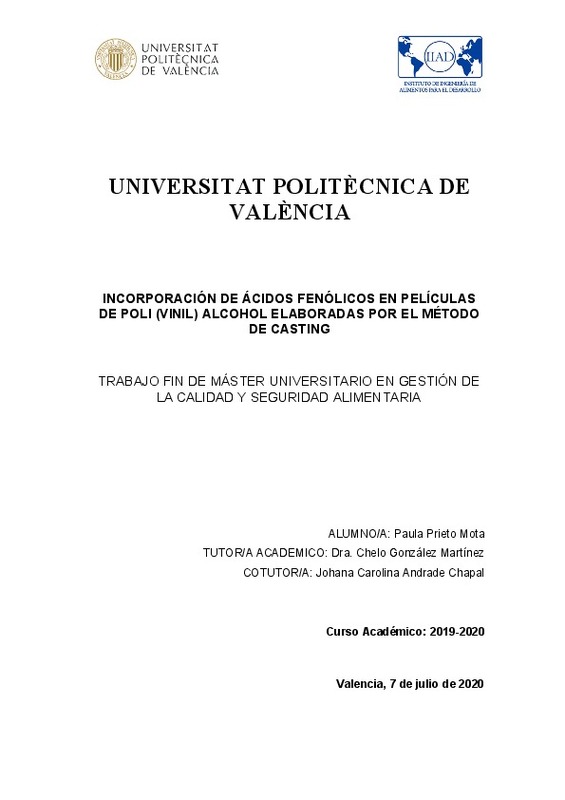|
Resumen:
|
[ES] El envase activo es un concepto innovador en la industria alimentaria, cuyo propósito es preservar la calidad de los alimentos y extender su vida útil. Los ácidos fenólicos son agentes activos ampliamente estudiados ...[+]
[ES] El envase activo es un concepto innovador en la industria alimentaria, cuyo propósito es preservar la calidad de los alimentos y extender su vida útil. Los ácidos fenólicos son agentes activos ampliamente estudiados debido a sus notables propiedades antioxidantes y antimicrobianas. En este sentido, su incorporación en matrices poliméricas biodegradables, como el poli (vinil alcohol) (PVA), permitiría obtener materiales activos para el envasado de alimentos con menor impacto ambiental. El objetivo de este trabajo fue evaluar el efecto de la inclusión de ácidos fenólicos en dos tipos de PVA (A: Mw 89,000-98,000; 99-99.8% hidrolizado y B: Mw 13,000-23,000; 87-89% hidrolizado) para obtener películas activas biodegradables que puedan ser utilizadas en envases alimentarios. Con este fin, se incorporaron dos ácidos fenólicos, el ácido cinámico y el ácido ferúlico (al 1 y 2% con respecto al polímero) en las dispersiones formadoras de película. Las películas se obtuvieron por casting y se caracterizaron en términos de solubilidad en agua, microestructura, propiedades mecánicas, térmicas y de barrera al vapor de agua y al oxígeno. Los resultados mostraron que la incorporación de ácidos fenólicos no afectó significativamente (p> 0.05) a las propiedades térmicas o barrera de las películas. Sin embargo, la solubilidad en agua de las películas de PVA-A se redujo al contener ácidos fenólicos (reducción del 28% en comparación con PVA-A puro), mientras que el módulo elástico (EM) de las películas de polímero-B aumentó (16%), pero solo cuando se añadió ácido ferúlico. El análisis microestructural reveló que la inclusión de ácido cinámico y ferúlico promovió cambios en la microestructura de la matriz de polímero A, probablemente como resultado de la hidrólisis de PVA, mientras que en el polímero B no se observaron cambios a nivel microestructural. En resumen, la inclusión de los ácidos fenólicos estudiados no afectó significativamente las propiedades físicas de los materiales poliméricos en las proporciones utilizadas, por lo que presentan un gran potencial para ser utilizados como materiales activos para el envasado de alimentos.
[-]
[EN] Active packaging is an innovative concept in the food industry, whose purpose is to preserve the quality of food and extend its shelf life. Phenolic acids are active agents widely studied due to their antioxidant and ...[+]
[EN] Active packaging is an innovative concept in the food industry, whose purpose is to preserve the quality of food and extend its shelf life. Phenolic acids are active agents widely studied due to their antioxidant and antimicrobial properties. Its incorporation into biodegradable polymer matrices, such as poly (vinyl alcohol) (PVA), would allow to obtain active materials for food packaging with less environmental impact. The objective of this work was to evaluate the effect of the inclusion of phenolic acids in two types of PVA (A and B) to obtain biodegradable active films that can be used in food packaging. For that purpose, two phenolic acids, cinnamic and ferulic (1% and 2% with regard to the polymer) were incorporated into the film-forming dispersions. Films were obtained by casting and they were characterized in terms of water solubility, microstructure, mechanical, thermal, and oxygen and water vapor barrier properties. The addition of phenolic acids, promoted changes in the microstructure of the samples of matrix A, but not in those of matrix B, which shows differences in the affinity between the acids and the different kinds of PVA. Ferulic acid reduced the water solubility of PVA A films, likewise, improved the oxygen barrier and reduced stiffness (films with 2% of ferulic acid). While in PVA B the stiffness of the films increased and the barrier properties of the films were improved in the films with a 1% of ferulic acid. Meanwhile, cinnamic acid does not have significant effects on the barrier and mechanical properties of the films, except when incorporating 1% in PVA A, it increases the oxygen barrier of the films. The thermal stability of the films was not affected in any case by the addition of phenolic acids. In conclusion, the active films of each type of PVA have great potential to be used in the development of food packaging.
[-]
|







